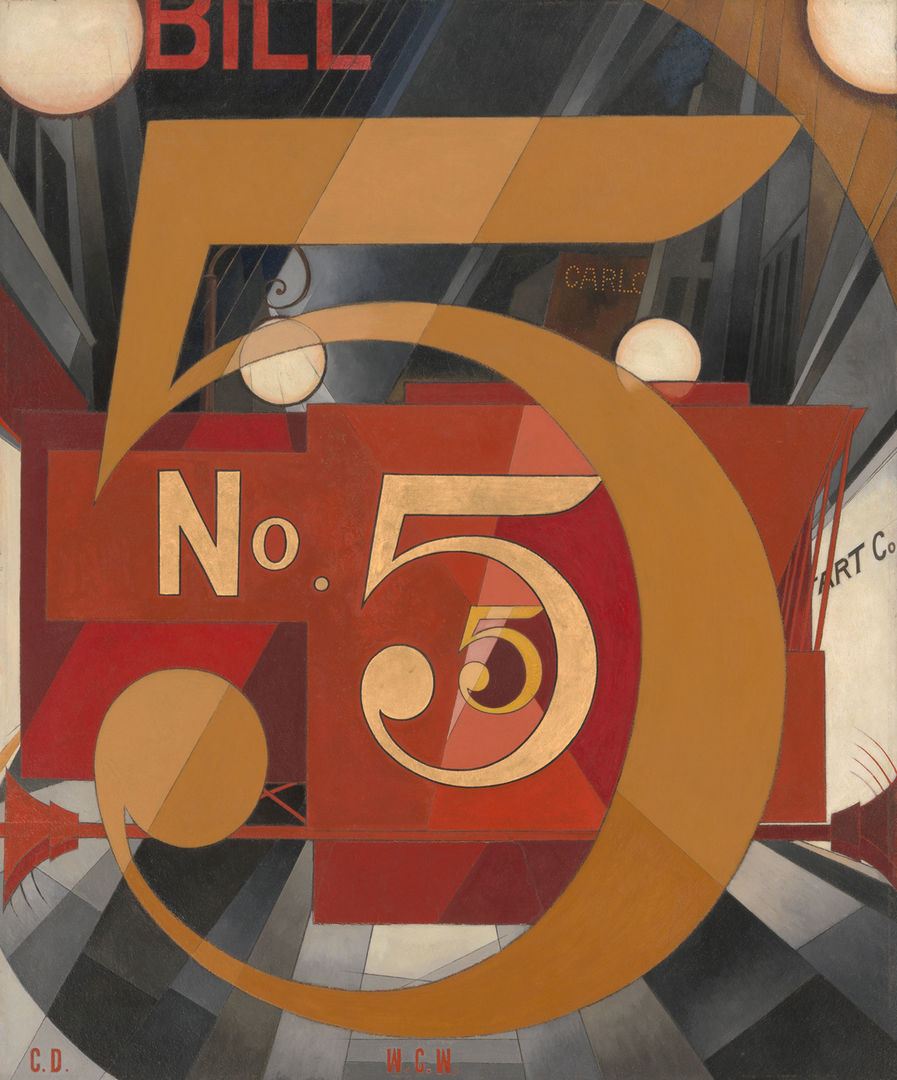Beyond the Figure

Charles Demuth (American, 1883–1935). I Saw the Figure 5 in Gold, 1928. Oil on cardboard, 35 1/2 x 30 in. (90.2 x 76.2 cm). The Metropolitan Museum of Art, New York, Alfred Stieglitz Collection, 1949 (49.59.1)
Collection Area: Modern and Contemporary Art
Subject Areas: English Language Arts, U.S. History, Visual Arts
Grades: Middle School, High School
Topics/Themes: Identity, Artist Choices
Goals
Students will be able to:
- identify ways artists convey personality in nonfigurative portraits;
- recognize similarities and differences in visual and verbal expression; and
- use text as a springboard for art making.
National Learning Standards
English Language Arts
NL-ENG.K-12.4 Communication Skills
NL-ENG.K-12.5 Communication Strategies
NL-ENG.K-12.12 Applying Language Skills
U.S. History
NSS-USH.K-12.7 Era 7: The Emergence of Modern America (1890–1930)
NSS-USH.K-12.8 Era 8: The Great Depression and World War II (1929–1945)
Visual Arts
NA-VA.K-12.3 Choosing and Evaluating a Range of Subject Matter, Symbols, and Ideas
NA-VA.K-12.4 Understanding the Visual Arts in Relation to History and Cultures
NA-VA.K-12.6 Making Connections between Visual Arts and Other Disciplines
Common Core State Standards
English Language Arts
CCSS.ELA-Literacy.CCRA.R.7 Integrate and evaluate content presented in diverse media and formats, including visually and quantitatively, as well as in words.
CCSS.ELA-Literacy.CCRA.R.9 Analyze how two or more texts address similar themes or topics in order to build knowledge or to compare the approaches the authors take.
Questions for Viewing
- Take a moment to look closely. What do you notice?
- What associations come to mind? What do you see that makes you say that?
- If you were going to describe this work to someone who had never seen it, what adjectives would you use? Why?
- If we turned up the "volume" of this painting, how might it sound? How has the artist created a sense of volume?
- What do you notice about the organization of the image? What impact does it have? Why?
- This painting was inspired by the life and poetry of William Carlos Williams. While many portraits describe how a person looks, this painting conveys a sense of identity through other means. How would you describe William Carlos Williams's personality based on what you see? What details support your interpretation?
Activity
Activity Setting: Classroom
Materials: Paper, pencils, copy of William Carlos Williams's poem "The Great Figure," image of the featured work of art, texts by authors the students admire
Subject Areas: English Language Arts, Visual Arts
Duration: 60 minutes
Explore the relationship between William Carlos Williams's poem "The Great Figure" and Charles Demuth's painting I Saw the Figure 5 in Gold. What do these two works have in common? What sets them apart? Select a piece of writing by a person you admire and highlight one or two sentences that capture his or her personality. Create a nonfigurative portrait of this person, using the text you selected as a source of inspiration.
Resources
"Charles Demuth: I Saw the Figure 5 in Gold (49.59.1)." In Heilbrunn Timeline of Art History. New York: The Metropolitan Museum of Art, 2000–. (October 2006)
Paul, Stella. Twentieth-Century Art: A Resource for Educators. New York: The Metropolitan Museum of Art, 1999.
Pre-Visit Guide for Teachers: Modern and Contemporary Art (PDF)
Sims, Lowery Stokes. The Figure in 20th Century American Art: Selections from the Metropolitan Museum of Art. New York: The Metropolitan Museum of Art, 1984.
Williams, William Carlos. "The Great Figure." Poetry Foundation, Chicago, 2000–.
Objects in the Museum's Collection Related to this Lesson
Marsden Hartley (American, 1877–1943). Portrait of a German Officer, 1914. Oil on canvas, 68 1/4 x 41 3/8 in. (173.4 x 105.1 cm). The Metropolitan Museum of Art, New York, Alfred Stieglitz Collection, 1949 (49.70.42)
Florine Stettheimer (American, 1871–1944). The Cathedrals of New York, 1929–44. Oil on canvas, 60 x 50 in. (152.4 x 127 cm). The Metropolitan Museum of Art, New York, Gift of Ettie Stettheimer, 1953 (53.24.2)
Adapted from Twentieth-Century Art: A Resource for Educators (The Metropolitan Museum of Art, 2010)